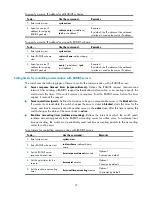
40
•
No authorization (none)
—The NAS performs no authorization exchange. After passing
authentication, non-login users can access the network, FTP users can access the root directory of
the NAS, and other login users have only the rights of Level 0 (visiting).
•
Local authorization (local)
—The NAS performs authorization according to the user attributes
configured for users.
•
Remote authorization (scheme)
—The NAS cooperates with a RADIUS or HWTACACS server to
authorize users. RADIUS authorization is bound with RADIUS authentication. RADIUS authorization
can work only after RADIUS authentication is successful, and the authorization information is
carried in the Access-Accept message. HWTACACS authorization is separate from HWTACACS
authentication, and the authorization information is carried in the authorization response after
successful authentication. You can configure local authorization or no authorization as the backup
method, which is used when the remote server is not available.
Before you configure authorization methods, complete the following tasks:
1.
For HWTACACS authorization, configure the HWTACACS scheme to be referenced first. For
RADIUS authorization, the RADIUS authorization scheme must be the same as the RADIUS
authentication scheme; otherwise, it does not take effect.
2.
Determine the access type or service type to be configured. With AAA, you can configure an
authorization scheme for each access type and service type, limiting the authorization protocols
that can be used for access.
3.
Determine whether to configure an authorization method for all access types or service types.
To configure AAA authorization methods for an ISP domain:
To do…
Use the command…
Remarks
1.
Enter system view.
system-view
—
2.
Enter ISP domain view.
domain
isp-
name
—
3.
Specify the default
authorization method for
all types of users.
authorization default
{
hwtacacs-scheme
hwtacacs-scheme-name
[
local
] |
local
|
none
|
radius-scheme
radius-scheme-name
[
local
] }
Optional.
It is set to
local
by default.
4.
Specify the command
authorization method.
authorization command
{
hwtacacs-scheme
hwtacacs-scheme-name
[
local
|
none
] |
local
|
none
}
Optional.
The default authorization
method is used by default.
5.
Specify the authorization
method for LAN users.
authorization lan-access
{
local
|
none
|
radius-scheme
radius-scheme-name
[
local
|
none
] }
Optional.
The default authorization
method is used by default.
6.
Specify the authorization
method for login users.
authorization login
{
hwtacacs-scheme
hwtacacs-scheme-name
[
local
] |
local
|
none
|
radius-scheme
radius-scheme-name
[
local
] }
Optional.
The default authorization
method is used by default.
The authorization method specified with the
authorization default
command is for all types of users and
has a priority lower than that for a specific access type.
If you configure an authentication method and an authorization method that use RADIUS schemes for an
ISP domain, the RADIUS scheme for authorization must be the same as that for authentication. If the
RADIUS authorization configuration is invalid or if RADIUS authorization fails, the RADIUS authentication
also fails. Whenever RADIUS authorization fails, an error message is sent to the NAS, indicating that the
server is not responding.
Содержание A5830 Series
Страница 207: ...199 Figure 62 SFTP client interface ...






























